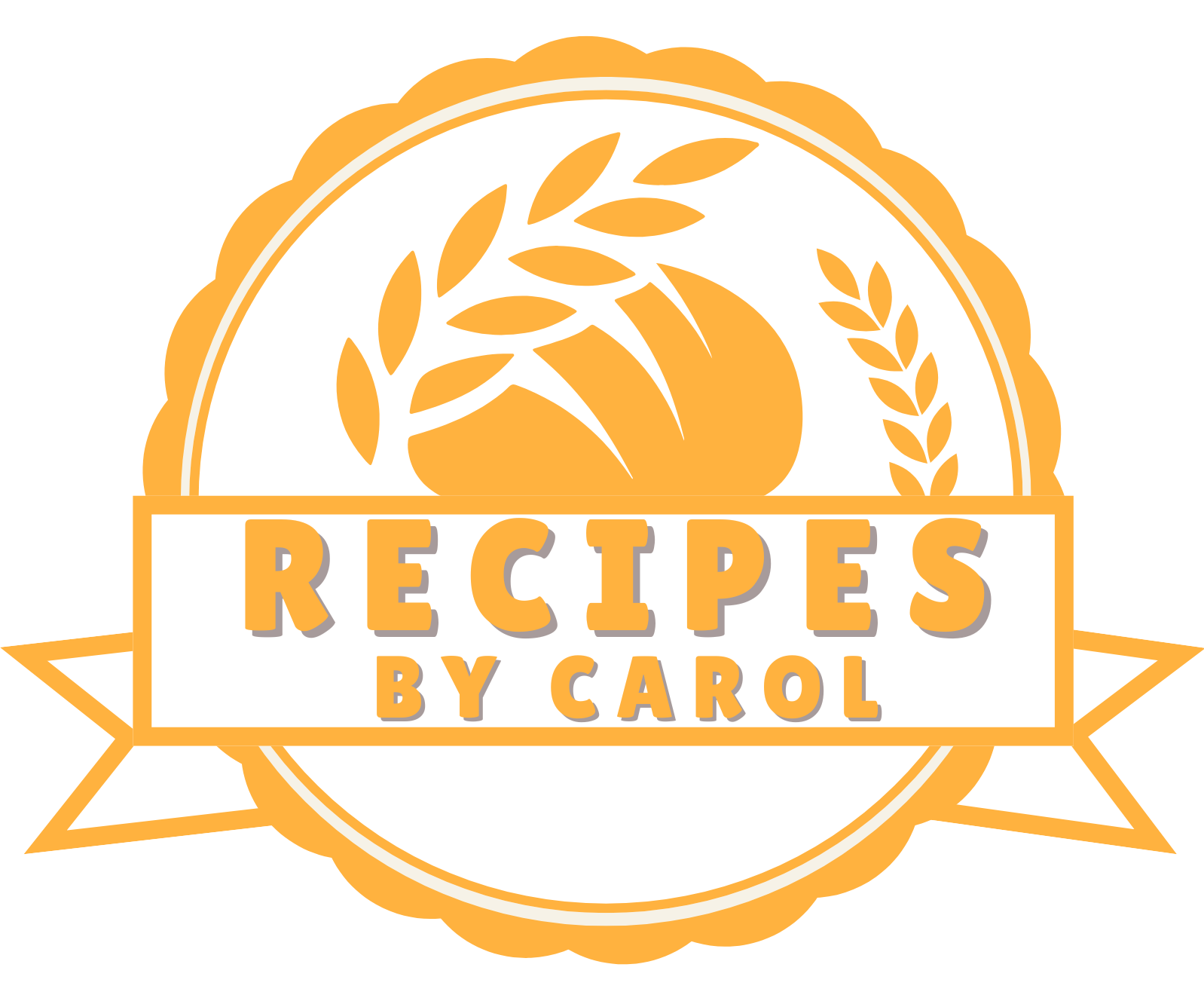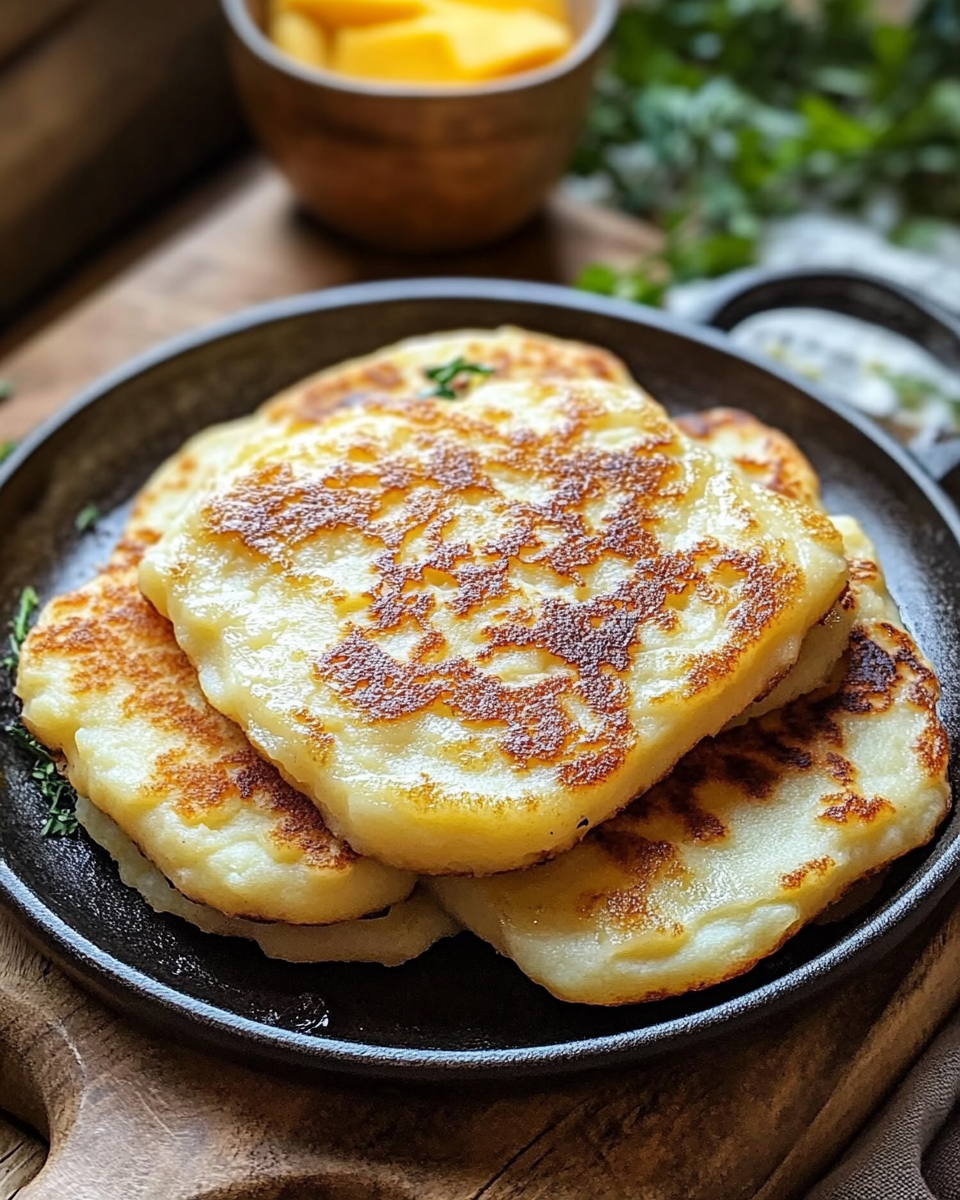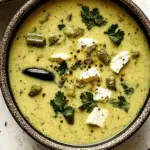Irish Potato Farls are a humble yet incredibly satisfying dish rooted in Irish culinary tradition. Their golden crust and tender interior make them ideal for pairing with butter, jam, or alongside savory dishes like a full Irish breakfast. The simplicity of ingredients shines through in their warm, comforting texture and flavor.
Perfect for breakfast or a light snack, these farls celebrate the versatility of potatoes in Irish cooking. Whether served fresh off the griddle or toasted the next day, their rustic charm invites you to slow down and enjoy a taste of Ireland’s rich food heritage.
Full Recipe:
Ingredients:
-
2 cups mashed potatoes (preferably leftover, cooled)
-
1 1/2 cups all-purpose flour, plus extra for dusting
-
1 teaspoon baking powder
-
1/2 teaspoon salt
-
Butter, for cooking
Directions:
-
In a large bowl, mix together the mashed potatoes, flour, baking powder, and salt until a soft dough forms.
-
Lightly flour a clean surface and roll the dough into a circle about 1/2 inch thick.
-
Cut the circle into 4 equal triangles (farls).
-
Heat a large skillet or griddle over medium heat and melt a little butter.
-
Cook each farl for 5-7 minutes on each side until golden brown and cooked through.
-
Serve warm with butter, jam, or alongside a traditional Irish breakfast.
Prep Time: 10 minutes | Cooking Time: 15 minutes | Total Time: 25 minutes
Kcal: Approximately 200 kcal per farl | Servings: 4 servings
Discovering the Charm of Irish Potato Farls: A Classic Taste of Ireland
Irish Potato Farls hold a special place in the heart of traditional Irish cuisine. This humble yet hearty dish has been a beloved staple in Irish households for generations, often enjoyed as a simple accompaniment to breakfast or a comforting snack throughout the day. At its core, a potato farl is a type of griddle bread made primarily from mashed potatoes, flour, and baking powder, cooked to a golden crisp on the outside while remaining soft and tender inside. It is a testament to the resourcefulness and simplicity that characterizes much of Irish cooking, where few ingredients come together to create something truly satisfying.
Historical Roots and Cultural Significance
The origins of Irish Potato Farls are deeply intertwined with the history of potatoes in Ireland. Introduced to Europe from the Americas in the late 16th century, the potato quickly became a vital food source for the Irish due to its adaptability and high yield in the country’s cool, wet climate. Over time, potatoes became the cornerstone of Irish diets, especially among rural communities and poorer households.
Potato farls emerged as an ingenious way to extend mashed potatoes and turn them into a filling bread substitute. The word “farl” comes from the Gaelic term “fardel,” meaning a fourth or quarter, referencing how the dough is traditionally divided into four pieces and cooked on a griddle or pan. This method of preparation allowed Irish families to enjoy bread-like fare without the need for yeast or an oven, which was often inaccessible.
Farls were commonly served alongside other traditional Irish dishes such as bacon, eggs, and black pudding, forming an integral part of the hearty Irish breakfast. Their popularity endures today, especially in Irish households and pubs, where they are often enjoyed with butter, jams, or stews.
Why Potato Farls Are So Special
What makes potato farls stand out is their simplicity and versatility. Unlike yeast breads, which require time to rise, potato farls come together quickly and cook fast on a stovetop, making them an ideal option for busy mornings or impromptu meals. The use of mashed potatoes adds moisture and tenderness to the dough, ensuring a soft crumb inside, while the griddle or pan cooking gives them a pleasingly crisp exterior.
Moreover, potato farls are naturally gluten-rich thanks to the potatoes, but their flour content means they are not gluten free, though they can be adapted for gluten-free diets using suitable flours. The flavor is mild and comforting, with a slight earthiness from the potato that pairs beautifully with sweet or savory toppings.
Cooking Tips for Perfect Potato Farls
To achieve the perfect potato farls, using leftover mashed potatoes is highly recommended. Leftover potatoes tend to be drier and firmer, which helps create a dough that holds together well without becoming too sticky or wet. If using freshly mashed potatoes, make sure they are cooled and not too buttery or creamy.
When mixing the dough, be gentle and avoid overworking it to keep the texture tender. Lightly flour your work surface and your hands to prevent sticking, but avoid adding too much flour, as this can make the farls tough.
The cooking temperature is also crucial medium heat works best to allow the farls to cook evenly without burning the outside while the inside cooks through. Cooking them too fast can leave the center undercooked, while too low heat may dry them out.
Don’t rush flipping! Let each side cook until it develops a rich golden crust before turning. The smell of cooking farls is wonderfully nostalgic and signals a comforting meal is ready to enjoy.
Serving Suggestions and Pairings
Irish Potato Farls are incredibly versatile and can be enjoyed in many ways. Traditionally, they are served with a pat of butter melting on top, sometimes accompanied by homemade jams or marmalade for a sweet contrast. They also make a perfect side to full Irish breakfasts alongside rashers (Irish bacon), sausages, eggs, and black pudding.
For a heartier snack or light lunch, farls can be split and used as bread for sandwiches, especially with smoked salmon, corned beef, or cheese. Their soft texture absorbs flavors well, making them ideal for pairing with rich gravies or stews.
You can also serve them toasted with a drizzle of honey or alongside a bowl of warm soup for a comforting winter meal. In modern kitchens, some people even experiment by adding herbs or cheese into the dough for extra flavor.
Variations Across Ireland and Beyond
While the classic potato farl remains beloved, regional and family variations abound. In some areas, buttermilk may be added to the dough for a slight tanginess and softer crumb. Others might sprinkle a bit of sugar or cinnamon for a subtly sweet version enjoyed as a breakfast treat.
Some recipes incorporate wholemeal or rye flour for a nuttier flavor and denser texture. There’s also a variation known as “potato cakes,” which are often thinner and sometimes fried rather than griddled.
The concept of potato-based breads or cakes is not unique to Ireland alone similar recipes exist in Scotland and parts of England, demonstrating the widespread culinary importance of the potato across the British Isles.
Nutritional Perspective
While Irish Potato Farls are certainly comforting and filling, they are also a relatively simple carbohydrate source. They offer energy primarily through the potatoes and flour, and when cooked in butter, they gain some fat content. Because of their basic ingredients, they can fit well into balanced diets when paired with protein-rich and vegetable-based foods.
Homemade versions are preferable to processed breads as they contain no preservatives or additives and can be customized to reduce fat or increase fiber by using whole-grain flours.
Bringing Potato Farls Into Modern Kitchens
Today, Irish Potato Farls are experiencing a resurgence among food enthusiasts and home cooks who appreciate their heritage and ease of preparation. They are perfect for anyone wanting to explore traditional Irish cuisine in a straightforward way.
Their simplicity makes them an ideal beginner recipe for bakers and cooks looking to experiment with breads without the complexity of yeast or lengthy rising times. They also offer an excellent use for leftover potatoes, promoting sustainability by reducing food waste.
Whether you’re hosting a St. Patrick’s Day celebration, seeking a nostalgic snack, or simply looking to diversify your breakfast repertoire, Irish Potato Farls deliver warmth, tradition, and deliciousness in every bite.
Conclusion:
Irish Potato Farls are much more than just a simple bread alternative they are a culinary symbol of Irish resourcefulness, comfort, and tradition. Their ease of preparation, delightful texture, and nostalgic flavor make them a timeless addition to any kitchen. Whether enjoyed hot off the griddle with butter and jam or alongside a hearty breakfast plate, they invite a moment of cozy indulgence and connection to Ireland’s rich food heritage.
Bringing Irish Potato Farls into your home means embracing a recipe that honors the past while still being adaptable for today’s tastes and dietary needs. Their enduring appeal lies in their simplicity and the way they bring people together over good food and shared history. So next time you want a comforting, quick bread, consider the humble Irish Potato Farl a slice of Ireland you can savor any day of the year.






